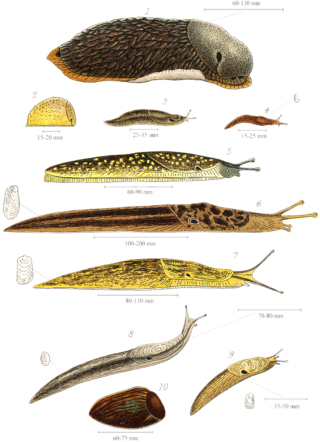
Rhabditida is an order of free-living, parasitic and microbivorous nematodes living in soil.

Caenorhabditis is a genus of nematodes which live in bacteria-rich environments like compost piles, decaying dead animals and rotting fruit. The name comes from Greek: caeno- ; rhabditis = rod-like.
Caenorhabditis brenneri is a small nematode, closely related to the model organism Caenorhabditis elegans. Its genome is being sequenced by Washington University in St. Louis Genome Sequencing Center. This species has previously been referred to as C. sp 4 and Caenorhabditis sp. CB5161, but was recently formally described and given its scientific name. This name is in honor of Sydney Brenner, recognizing his pioneering role in starting active research in the field of C. elegans biology and development.

Diplogasterida was an order of nematodes. It was sometimes placed in a monotypic subclass Diplogasteria, but molecular phylogenetic evidence has shown it to be embedded in the family Rhabditidae. The confusion of having a hierarchical nesting of groups that were formerly mutually exclusive has led to a profusion of names. Although completely revised taxonomy of nematodes that builds on recent classification systems as well as recent phylogenetic evidence is still necessary, most contemporary taxonomic studies now treat all groups listed under "Diplogasterina" below as a single family, Diplogastridae.

Slug, or land slug, is a common name for any apparently shell-less terrestrial gastropod mollusc. The word slug is also often used as part of the common name of any gastropod mollusc that has no shell, a very reduced shell, or only a small internal shell, particularly sea slugs and semi-slugs.
The Rhabditidae are a family of nematodes which includes the model organism Caenorhabditis elegans.
Moraxella osloensis is a Gram-negative oxidase-positive, aerobic bacterium within the family Moraxellaceae in the gamma subdivision of the purple bacteria.

Phasmarhabditis hermaphrodita is a facultative parasitic nematode that can kill slugs and snails. It belongs to the family Rhabditidae, the same family as Caenorhabditis elegans.
Caenorhabditis remanei is a species of nematode found in North America and Europe, and likely lives throughout the temperate world. Several strains have been developed in the laboratory.

Deroceras invadens is a species of air-breathing land slug, a terrestrial pulmonate gastropod mollusc in the family Agriolimacidae. Until 2011, this widely distributed species was known as Deroceras panormitanum, and earlier as Deroceras caruanae or Agriolimax caruanae, but Reise et al. (2011) showed that these names refer to a distinct species of similar external appearance known at that time only from Sicily and Malta. Consequently, although the more widespread species was already well known, it then had to be redescribed under the new name of D. invadens. Genetic evidence has indicated that D. invadens is native in southern Italy, including parts of Sicily, and possibly parts of central Italy. Elsewhere it has been introduced, predominantly within the last 100 years, but its spread has been constrained by cold winter temperatures.

Diplogastridae, formerly Diplogasteridae, are a family of nematodes (roundworms) known from a wide range of habitats, often in commensal or parasitic associations with insects.
Phasmarhabditis californica is a nematode in the family Rhabditidae. It is a lethal facultative parasite of terrestrial gastropods.
Phasmarhabditis (Greek: Phasma = (φάσμα ; rhabditis = is a genus of bacterial-feeding nematodes which are facultative parasites whose primary hosts are terrestrial gastropods. The name comes from Greek: Phasma- (φάσμα ; rhabditis = rod-like (ῥάβδος. The genus is made up of 18 species including P. hermaphrodita, P. californica, P. neopapillosa, P. papillosa, P. apuliae, P. bohemica, P. bonaquaense, P. huizhouensis, P. nidrosiensis, P. valida and P. tawfiki.
Victor Marc Nigon was a biologist who was first to study the nematode worm Caenorhabditis elegans in the laboratory, with Ellsworth Dougherty, in the 1940s.
Diploscapter is a genus of nematodes in the family Rhabditidae.
Oscheius is a genus of nematode.
Oscheius tipulae is a species of nematodes, described in association of the leatherjacket, the larva of Tipula paludosa.
Protorhabditis is a genus of nematodes in the family Rhabditidae.
Necromeny is a symbiotic relationship where an animal infects a host and waits inside its body until its death, at which point it develops and completes its life-cycle on the cadaver, feeding on the decaying matter and the subsequent bacterial growth. As the necromenic animal benefits from the relationship while the host is unharmed, it is an example of commensalism.




